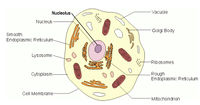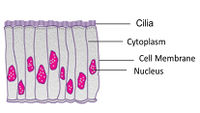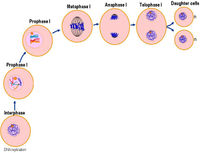Histologic:Chapter 2
Contents
Cells, Organelles, and Inclusions
To begin the study of cellular structure, you are asked to identify several kinds of cells, cellular specializations and inclusions of cells. Learn to distinguish between the nucleolus, the nucleus, and the cytoplasm of a cell. Observe the appearance of the chromatin, the position of the nucleus within the cell and the staining characteristics of the cytoplasm. Note the size of the cells, the density of similar cells, and their arrangement in the tissue. As you study the different cell types, keep in mind that sectioned material is being observed and that the appearance of the cell may vary depending on the plane of section.
A cell usually contains only one nucleus, but some cells may be binucleate. The nucleus often conforms to the shape of the cell being spherical, ovoid, or elongated. Other nuclei may be crescent shaped or lobated. It can be flattened towards the base of the cell when the pressure from cytoplasmic constituents “pushes it” there. Nucleoli may or may not be present. In sectioned material, the nucleus or nucleolus may appear to be absent from a cell because they were not in the plane of sectioning. If the cell is in a phase of mitosis, the nucleus will appear different from nuclei of other non-mitotic cells of the tissue.
The cytoplasm often exhibits modifications according to the specific functions of the cell or the tissue. Muscle cells have contractile myofibrils. Secretory cells of the salivary glands possess numerous secretory granules. Epithelial cells of the skin produce a protein called keratin for protection. The epithelial lining of the respiratory tract may possess cilia. White blood cells may contain primary and specific granules. Neurons possess neurofibrils, etc. The list is almost endless.
NOTE: The objective of this first exercise is merely to gain an awareness of the varieties of cell sizes, cell shapes, cell types, cell staining characteristics and cell organelles or inclusions. You are not expected, at this time, to become familiar with the over-all structure of the tissues and organs where these cells are located.
Microscopic Study: Architecture
Slide 25: Spinal Cord (H&E)
On slide 25, Spinal Cord (H&E) find under low power the cell bodies of multipolar neurons located in the two anterior horns of the gray matter (if the slide is held towards the light, the gray matter appears H-shaped). With medium power, identify a cell body containing a large pale nucleus and a darkly stained nucleolus. Study this cell under high power. The irregular, granular-like, basophilic staining masses within the cytoplasm are called Nissl bodies. They consist of free ribosomes and granular endoplasmic reticulum.
Slide 73: Spinal Ganglion (Silver)
On slide 73, Spinal Ganglion (silver) identify the large cell bodies of the ganglion cells associated with the sensory root of spinal nerves. The cell bodies of these unipolar neurons range in size from 15μm to 100μm. Compare a number of ganglion cell bodies for size differences. The centrally located nuclei stain palely and appear as clear spaces in the middle of the granular cytoplasm. With careful observation you will see nuclei of much smaller cells immediately surrounding the cell bodies of the ganglion cells. These represent satellite cells. Note how much smaller they are than the nuclei of the ganglion cells.
Slide 149: Liver (H&E)
On slide 149, Liver (H&E) observe that the hepatocytes (liver parenchymal cells) appear to be arranged as rows or cords of cells. Actually the tridimensional arrangement of these cells is in cellular sheets or plates which are separated by blood-filled spaces called sinusoids. Red blood corpuscles may be seen in some of the sinusoids. Note that cell boundaries can be distinctly seen between many of the liver cells. The polyhedral- shaped hepatocytes have round, centrally located nuclei containing one or more nucleoli and scattered clumps of chromatin. Binucleated hepatocytes can be found. Note the granularity of the eosinophilic staining cytoplasm
Slide 154: Pancreas (H&E)
Slide 154, Pancreas (H&E) has cells which distinctly exhibit a difference between basophilic regions and acidophilic regions. After studying the cells with medium power, turn to high power to complete your study. Observe that the cell boundaries are indistinct. Note that the cytoplasm in the basal region of the acinar cells is basophilic. Here the ribonucleoproteins associated with rough endoplasmic reticulum and the large numbers of mitochondria are sufficiently dense to stain with the basic dye. Note, however, the red staining of the apical half of the acinar cells. This acidophilic staining cytoplasm contains numerous secretory granules that stain brightly with the eosin stain. The nuclei are basophilic staining as are the nuclei of all cells. Observe that the nuclei are characteristically located in the basal one-third of the cell. Nucleoli may be seen in many cells.
Microscopic Study: Cell Types
Slide 2: Trachea (H&E)
On slide 2, Trachea (H&E) identify the cilia on the tall cells of the pseudostratified columnar epithelium that line the lumen of the trachea. Each cilium is derived from a basal body, represented here in aggregate by the dark lines where the cilia attach to the cell. In some regions of this tissue the cilia are absent or the entire epithelium is missing. This is artifact.
Slide 89: Skeletal Muscle (H&E)
On slide 89, Skeletal Muscle (H&E) identify muscle fibers cut in longitudinal section. Under high power note the striated appearance of the muscle cells. Although not readily visible, the cytoplasm of these cells contains myofibrils, the contractile elements of the cell. The arrangement of these myofibrils and their subunits, the myofilaments, impart the striated appearance to the muscle fibers.
Slide 31: Ileum (H&E)
On slide 31, Ileum (H&E) identify with low power the villi projecting from one side of the tissue. With high power identify the tall cells (simple columnar cells) which cover these villi. On the free surface of these cells can be seen a dense line representing the striated border. This border consists of cytoplasmic processes termed microvilli that greatly increase the absorptive area of the small intestine. In light microscopy, the microvilli appear vertically striated so these projections form a “striated border.”
Mitosis
Mitosis can be viewed as the means whereby identical genetic material, contained in the chromosomes, is distributed to two daughter nuclei. It can be divided into four stages, each characterized by certain features of nuclear or chromosome morphology and chromosome movement. The stages are arbitrary in that mitosis is a continuous process from its inception at prophase through the stages of metaphase and anaphase to the final stage of telophase. The nucleus of a cell that is not dividing is in the interphase stage.
The number of mitotic figures in a tissue is an index of the rate of turnover of the component cells. In benign tumors, mitotic figures are few in numbers, whereas in malignant tumors, mitotic figures are more numerous and may include many bizarre forms. Hence, the recognition of mitotic figures is one criterion for the interpretation of various kinds of pathology of a tissue.
Microscopic Study: Mitosis
On slide 34, Mitosis (Iron H), are longitudinal sections of onion root tips in which cells have been fixed in various stages of mitosis. Learn to identify the characteristic arrangement of the chromatin in each state.
Slide 34: Mitosis (Iron H)
| ||||||||||||||||||||||||||||||||||||||||||||||||||||||||||||||


